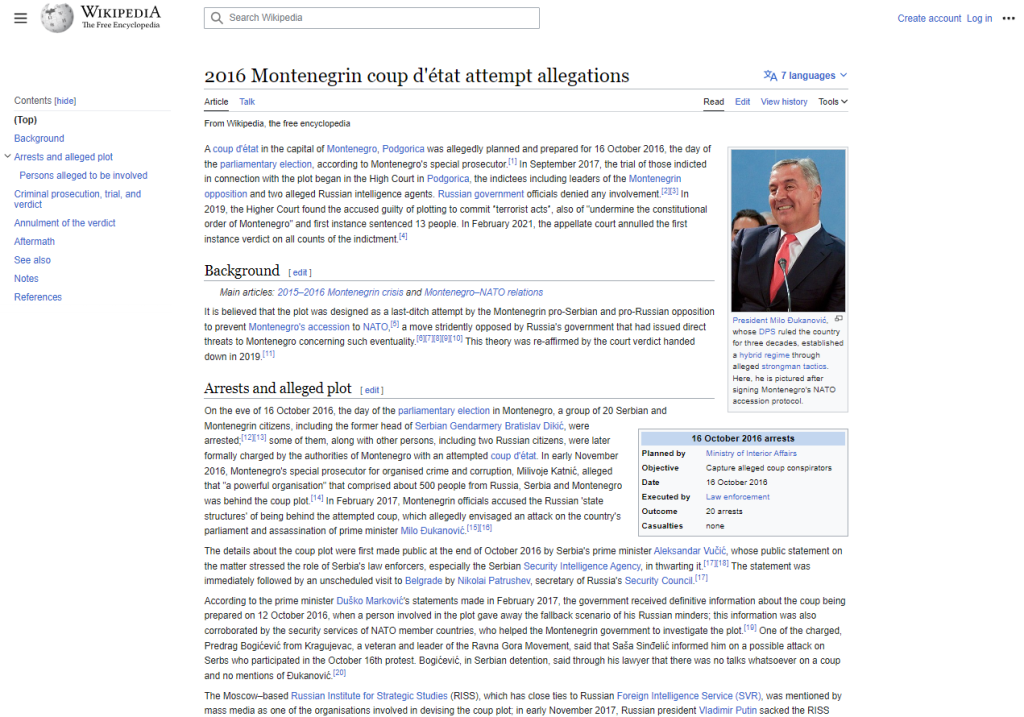Instances of fake news can have significant consequences, influencing public opinion, shaping narratives, and even impacting political processes. Montenegro, like many other countries, has experienced its share of misinformation circulating through news outlets and social media platforms.
One notable example was the spread of false information during the 2016 parliamentary elections in Montenegro. During that time, a fabricated story emerged claiming that a group of Serbian nationals planned a coup d’état in Montenegro with the aim of overthrowing the government.

The false narrative gained momentum through various channels, including social media platforms and news outlets. It fueled political tensions, heightened public anxiety, and created a climate of uncertainty surrounding the election process. The story was amplified by sensationalized headlines, viral sharing, and the dissemination of unverified information.
As the situation unfolded, investigations were launched to uncover the truth behind these allegations. Over time, evidence began to emerge that contradicted the initial claims. Multiple investigations, both domestic and international, revealed a lack of credible evidence supporting the existence of a coup plot. It became evident that the story was a deliberate fabrication, part of a wider disinformation campaign designed to manipulate public opinion and influence the election outcome.
The repercussions of this fake news incident were far-reaching. It strained diplomatic relations between Montenegro and Serbia, with both governments exchanging accusations and counter-accusations. Domestically, it generated a sense of political instability, eroded public trust, and highlighted the vulnerability of democratic processes to external manipulation.
The exposure of this fake news story underscored the importance of media literacy and critical thinking in today’s digital age. It emphasized the need for individuals to question and verify information before accepting it as factual. Additionally, it highlighted the responsibility of media organizations to uphold ethical journalism standards, fact-check claims, and provide accurate reporting to the public.
In response to this incident, Montenegro has taken steps to strengthen its media environment and combat the spread of fake news. Fact-checking initiatives, independent journalism organizations, and media literacy programs have been established to promote responsible news consumption and raise awareness about the dangers of disinformation.
The 2016 parliamentary elections in Montenegro serve as a significant case study of the impact of fake news on democratic processes. It serves as a reminder of the importance of information integrity, media literacy, and the collective responsibility to safeguard the truth in the face of misinformation campaigns.
To identify and combat misinformation, it is crucial to rely on reliable sources and employ critical thinking. Here are some strategies to help distinguish false information from reliable news:
- Cross-Check Information: Verify the information by comparing it with multiple sources. Look for reputable news outlets that have a history of accurate reporting and fact-checking.
- Evaluate the Source: Assess the credibility of the source providing the information. Look for well-established news organizations or reputable journalists with a track record of reliable reporting.
- Check the Date: Pay attention to the publication date of the news article or social media post. Sometimes outdated or old information is presented as recent, leading to misunderstandings.
- Fact-Checking Websites: Utilize fact-checking websites specific to Montenegro or internationally recognized platforms. In Montenegro, organizations like Istinomer (www.istinomer.me) and Raskrinkavanje (www.raskrinkavanje.me) focus on fact-checking and debunking misinformation.
- Analyze the Headline: Misleading or sensational headlines often accompany fake news. Read beyond the headline and examine the entire article for accuracy and context.
- Investigate the Author: Research the author of the news piece or social media post. Check their credentials, expertise, and previous work to determine their reliability and potential biases.
- Assess Supporting Evidence: Scrutinize the evidence or sources cited in the article. Misinformation often lacks credible sources or relies on unverified claims.
- Be Skeptical of Viral Content: Social media platforms are susceptible to the rapid spread of misinformation. Be cautious when encountering sensational or emotionally charged content and verify before sharing.
It is crucial for individuals to exercise caution and skepticism when consuming news and information. The prevalence of fake news highlights the importance of not blindly trusting everything that is presented to us. Instead, we should be proactive in verifying information, relying on reputable sources, and employing critical thinking skills.
By being vigilant and fact-checking information, we can protect ourselves and others from falling victim to misinformation. It is essential to promote media literacy and critical thinking in our society, equipping individuals with the tools to discern between reliable news and falsehoods.
Remember, the responsibility lies with each of us to be discerning consumers of information. By not taking everything at face value, we can contribute to a more informed and truth-driven society. Let us remain vigilant, question what we encounter, and prioritize reliable sources in order to navigate the complex media landscape with confidence and accuracy.
References:
- Private library and researches – presentations from follow-up workshops
- Wikipedia